Rachel Huffmire's Blog, page 4
November 24, 2020
Margaretha von Waldeck: The Truth Behind Snow White.
 What if fairy tales are rooted in truth? Often, when something is so far-fetched or unbelievably perfect, we accuse it of being a fairy tale. So why not? When I began historical research for my
time travel retelling of Snow White
, I stumbled across a startling tidbit of information—the Grimm Brothers might not have made up the story of Snow White. Here is some of the surprising research I gathered before writing my novel (sources are included).
What if fairy tales are rooted in truth? Often, when something is so far-fetched or unbelievably perfect, we accuse it of being a fairy tale. So why not? When I began historical research for my
time travel retelling of Snow White
, I stumbled across a startling tidbit of information—the Grimm Brothers might not have made up the story of Snow White. Here is some of the surprising research I gathered before writing my novel (sources are included).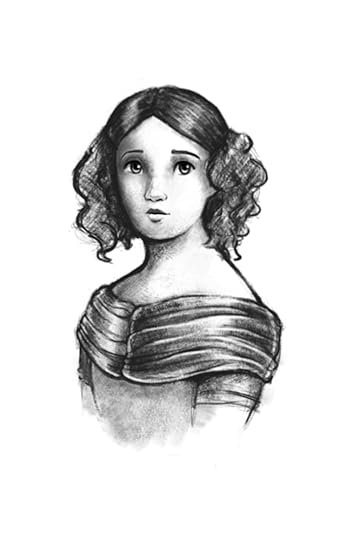 Snow WhiteMargaretha von Waldeck was a German countess born in 1533. Local records state that she was an exceptional beauty. (1.) She was named after her mother, Margareta who died when she was only four years old. (2.) Her father, Philip IV remarried Katherina von Hatzfeld. Apparently, their new mother was not very fond of Philip's children and sent many of them off to live with relatives. When Margaretha was 16, she went to live with her uncle Johann Cirksena in Brussels at the Valkenburg Castle. (3.) As she was presented in court, she caught the eye of three high standing nobles, including Prince Philip II of Spain who fell hopelessly in love with her. The King of Spain did NOT approve of the match, as he expected his son to marry for the gain of the kingdom. An alleged assassin was hired, and Margaretha slowly fell into a serious illness at the age of 21. Many of her friends commented that they believed Margaretha had been poisoned by degrees. Her last will and testament was written in a shaky hand, convincing historians that her death was indeed from unnatural causes. DwarvesFunctioning copper mines scattered the area surrounding Margaretha's home, most of which were operated with child labor and owned by Margaretha's brother. Work conditions were horrible, and the hard labor often stunted the growth of the children so they never grew to full height, dwarfing them. (5.) It is supposed that the mine gasses also grayed their hair prematurely. The workers lived in small cottages that often housed up to thirty occupants at a time.
Snow WhiteMargaretha von Waldeck was a German countess born in 1533. Local records state that she was an exceptional beauty. (1.) She was named after her mother, Margareta who died when she was only four years old. (2.) Her father, Philip IV remarried Katherina von Hatzfeld. Apparently, their new mother was not very fond of Philip's children and sent many of them off to live with relatives. When Margaretha was 16, she went to live with her uncle Johann Cirksena in Brussels at the Valkenburg Castle. (3.) As she was presented in court, she caught the eye of three high standing nobles, including Prince Philip II of Spain who fell hopelessly in love with her. The King of Spain did NOT approve of the match, as he expected his son to marry for the gain of the kingdom. An alleged assassin was hired, and Margaretha slowly fell into a serious illness at the age of 21. Many of her friends commented that they believed Margaretha had been poisoned by degrees. Her last will and testament was written in a shaky hand, convincing historians that her death was indeed from unnatural causes. DwarvesFunctioning copper mines scattered the area surrounding Margaretha's home, most of which were operated with child labor and owned by Margaretha's brother. Work conditions were horrible, and the hard labor often stunted the growth of the children so they never grew to full height, dwarfing them. (5.) It is supposed that the mine gasses also grayed their hair prematurely. The workers lived in small cottages that often housed up to thirty occupants at a time.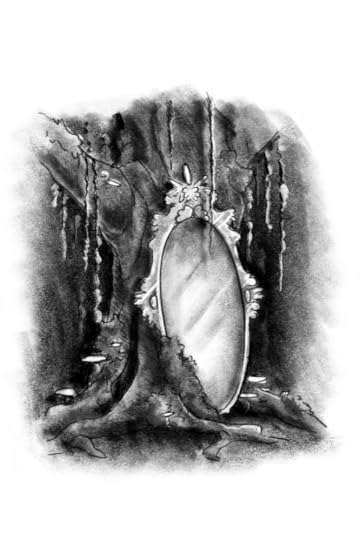 The Magic MirrorIn a neighboring kingdom of Lohr, was another princess, Maria Sophia Margaretha Catherina von Erthal. There is often some debate between the castles of Lohr and Waldeck about who was the true inspiration for the Snow White tale. I think it is likely the Grimm brothers drew from multiple fantastical stories from the area to compile into their fairy tale. After Maria's mother died and her father remarried, a large looking glass was given to her step-mother as a gift. The mirror still stands in the Lohr Schloss where tourists are told of the connection to the Snow White fairy tale. (6.) The high-quality glassworks of the area were known to be so clear that they "only spoke the truth" and contained little aphorisms in the upper left corner meant to inspire self-love. Poisoned ApplesThere are records of a man in the village of Wildungen who became fed up with local thieves and began handing out poisoned apples to the children he suspected were stealing from him. (7.) The man was later arrested and his crime became well known in the area. These were just some of the real-life historical elements that I found while researching for my novel,
Shattered Snow
. The main thing that inspired me was how the Grimm brothers weren't satisfied with Margaretha's sad tale, and immortalized her happily ever after with a new ending. It inspired me to write an alternative history of my own.
The Magic MirrorIn a neighboring kingdom of Lohr, was another princess, Maria Sophia Margaretha Catherina von Erthal. There is often some debate between the castles of Lohr and Waldeck about who was the true inspiration for the Snow White tale. I think it is likely the Grimm brothers drew from multiple fantastical stories from the area to compile into their fairy tale. After Maria's mother died and her father remarried, a large looking glass was given to her step-mother as a gift. The mirror still stands in the Lohr Schloss where tourists are told of the connection to the Snow White fairy tale. (6.) The high-quality glassworks of the area were known to be so clear that they "only spoke the truth" and contained little aphorisms in the upper left corner meant to inspire self-love. Poisoned ApplesThere are records of a man in the village of Wildungen who became fed up with local thieves and began handing out poisoned apples to the children he suspected were stealing from him. (7.) The man was later arrested and his crime became well known in the area. These were just some of the real-life historical elements that I found while researching for my novel,
Shattered Snow
. The main thing that inspired me was how the Grimm brothers weren't satisfied with Margaretha's sad tale, and immortalized her happily ever after with a new ending. It inspired me to write an alternative history of my own.  Shattered Snow is a time-travel retelling of Snow White
, based on the real-life history of Margaretha von Waldeck. "Charming, addictive, and sets the bar for all fairytale retellings." -Readers' Favorite Five Star Read"A beautiful reimagining filled with engaging new characters and fresh new ideas. Literary escapism achieved!" -Brian Crosby, Creative Director of Marvel Themed Entertainment.
Shattered Snow is a time-travel retelling of Snow White
, based on the real-life history of Margaretha von Waldeck. "Charming, addictive, and sets the bar for all fairytale retellings." -Readers' Favorite Five Star Read"A beautiful reimagining filled with engaging new characters and fresh new ideas. Literary escapism achieved!" -Brian Crosby, Creative Director of Marvel Themed Entertainment.A magic mirror could change her destiny.
Margaretha von Waldeck is a young German countess who desires nothing more than to honor her father and live up to her step-mother's expectations. But, when she discovers a mysterious mirror in the woods that transforms her world into shadows and ice, her future shatters.
Keltson Grammar is a time traveling vigilante who doesn’t mind breaking a few international laws. Hiding behind mirrors, he rescues unfortunate souls in the past and leads them to happier endings. When he sends his newest assistant to save a young countess from being poisoned, a single misstep sets a huntsman on his trail.
If Keltson is discovered, Margaretha's story will be reset to its original dismal fate, and Keltson’s future will end permanently behind bars.
★2019 Swoony Award Winner: Best Fairytale Retelling Romance ★2019 Whitney Award Finalist: YA Speculative Fiction ★Deep Magic Ezine highlighted novel, Fall 2019
Sources: 1. Schneewittchen: blonde Tochter einer Adligen aus Ostfriesland: Eine historische Spurensuche BoD 2013, Dekker, p. 33.2. https://www.familysearch.org/tree/person/details/LHWH-ZGS 3. Grudrun Anne Dekker, Schneewittchen: blonde Tochter einer Adligen aus Ostfriesland: Eine historische Spurensuche, BoD 2013. Dekker, pp. 31-324. Schneewittchen: blonde Tochter einer Adligen aus Ostfriesland: Eine historische Spurensuche BoD 2013, Dekker, p. 405. Schneewittchen: Marchen oder Wahrheit?, Sanders6. Werner Loibl, Die kurmainzische Spiegelmanufaktur Lohr am Main in der Zeit Kurfürst Lothar Franz von Schönborn (1698-1729), p.277f, in the catalogue: Glück und Glas, Zur Kulturgeschichte des Spessarts, Munich, 1984; Loibl is the foremost expert in the history of 17th and 18th-century glasshouses in Germany, according to Dedo von Kerssenbrock-Krosigk, formerly Curator of European Glass at the Corning Museum of Glass (Corning, NY), since 2008 Director of the Hentrich Museum of Glass (Düsseldorf, Germany). Cf. now the history of the 17th- and 18th-century glasshouses in Lohr and in the Spessart written by Werner Loibl: Die kurmainzische Spiegelmanufaktur Lohr am Main (1698 - 1806) und die Nachfolgebetriebe im Spessart, 3 volumes, Aschaffenburg 2012, ISBN978-3-87965-118-4.7. https://andreacefalo.com/2016/03/17/w...Margaretha von Waldeck, the truth behind Snow White.
 Often times, when something is so far fetched or unbelievably perfect, we accuse it of being a fairy tale. But what if fairy tales are rooted in truth?
Often times, when something is so far fetched or unbelievably perfect, we accuse it of being a fairy tale. But what if fairy tales are rooted in truth? When I began historical research for my time travel retelling of Snow White, I stumbled across a startling tidbit of information—the Grimm Brothers might not have made up the story of Snow White. Here is some of the surprising research I gathered before writing my novel.
 Snow White
Snow WhiteMargaretha von Waldeck was a German countess born in 1533. Local records state that she was an exceptional beauty. (1.) She was named after her mother, Margareta who died when she was only four years old. (2.) Her father, Philip IV remarried Katherina von Hatzfeld. Apparently their new mother was not very fond of her new children and sent many of them off to live with relatives. When Margaretha was 16, she went to live with her uncle Johann Cirksena in Brussels at the Valkenburg Castle. (3.) As she was presented in court, she caught the eye of three high standing nobles, including Prince Philip II of Spain who fell hopelessly in love with Margaretha. Philip's father (the king of Spain) did NOT approve of the match and expected his son to marry for the gain of the kingdom. An alleged assassin was hired, and Margaretha slowly fell into a serious illness at the age of 21. Many of her friends commented that they believed Margaretha had been poisoned by degrees. Her last will and testament was written in a shaky hand, convincing historians that her death was indeed from unnatural causes. (4.)
Dwarves
The surrounding area was littered with functioning copper mines, most of which were operated with child labor and owned by Margaretha's brother. Work conditions were horrible, and the hard labor often stunted the growth of the children so they never grew to full height, dwarfing them. (5.) It is supposed that the mine gasses also grayed their hair prematurely. The workers lived in small cottages that often housed up to thirty occupants at a time.
 The Magic Mirror
The Magic MirrorIn a neighboring kingdom of Lohr, was another princess, Maria Sophia Margaretha Catherina von Erthal. There is often some debate between the castles of Lohr and Waldeck about who was the true inspiration for the Snow White tale. I believe it is very likely that the Grimm brothers drew from multiple fantastical stories from the area to compile into their fairy tale. After Maria's mother died and her father remarried, a large looking glass was given to her step-mother as a gift. The mirror still stands in the Lohr Schloss where tourists are told of the connection to the Snow White fairy tale. (6.) The high-quality glassworks of the area were known to be so clear that they "only spoke the truth" and contained little aphorisms in the upper left corner meant to inspire self-love.
Poisoned Apple
There are records of a man in the village of Wildungen who became fed up with local thieves and began handing out poisoned apples to the children he suspected were stealing from him. (7.) The man was later arrested and his crime became well known in the area.
These were just some of the real-life historical elements that I found while researching for my novel, Shattered Snow . The main thing that inspired me was how the Grimm brothers weren't satisfied with Margaretha's sad tale, and immortalized her happily ever after with a new ending. It inspired me to write an alternative history of my own.
Shattered Snow is a time-travel retelling of Snow White, based on the real-life history of Margaretha von Waldeck. It is a Swoony Award Winner for best fairy tale retelling romance, a Whitney Award finalist, and a Deep Magic E-zine highlighted novel. Its sequel, Spinning Briar, is a retelling of Charles Perrault's Sleeping Beauty and is set in Medieval France. The final installment of the trilogy, Saving Winter, is a retelling of Hans Christian Anderson's The Snow Queen, and is set for release in 2021. View the series on Amazon today!
Sources:
1. Schneewittchen: blonde Tochter einer Adligen aus Ostfriesland: Eine historische Spurensuche BoD 2013, Dekker, p. 33.
2. https://www.familysearch.org/tree/person/details/LHWH-ZGS
3. Grudrun Anne Dekker, Schneewittchen: blonde Tochter einer Adligen aus Ostfriesland: Eine historische Spurensuche, BoD 2013. Dekker, pp. 31-32
4. Schneewittchen: blonde Tochter einer Adligen aus Ostfriesland: Eine historische Spurensuche BoD 2013, Dekker, p. 40
5. Schneewittchen: Marchen oder Wahrheit?, Sanders
6. Werner Loibl, Die kurmainzische Spiegelmanufaktur Lohr am Main in der Zeit Kurfürst Lothar Franz von Schönborn (1698-1729), p.277f, in the catalogue: Glück und Glas, Zur Kulturgeschichte des Spessarts, Munich, 1984; Loibl is the foremost expert in the history of 17th and 18th-century glasshouses in Germany, according to Dedo von Kerssenbrock-Krosigk, formerly Curator of European Glass at the Corning Museum of Glass (Corning, NY), since 2008 Director of the Hentrich Museum of Glass (Düsseldorf, Germany). Cf. now the history of the 17th- and 18th-century glasshouses in Lohr and in the Spessart written by Werner Loibl: Die kurmainzische Spiegelmanufaktur Lohr am Main (1698 - 1806) und die Nachfolgebetriebe im Spessart, 3 volumes, Aschaffenburg 2012, ISBN978-3-87965-118-4.
7. https://andreacefalo.com/2016/03/17/w...
November 17, 2020
Recommended Retelling: Deleted, by Ruth Mitchell
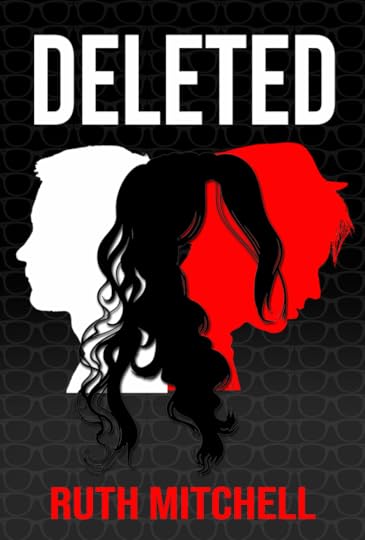
When I first became an acquisitions editor for a small publisher, I had no idea what an amazing roller coaster ride it would be. Sending rejection letters to my fellow authors was tough. I knew how hard it was to be in the query trenches, but even though I was reading plenty of manuscripts, I wasn't finding any that captivated me.
Until this one.
I saw Ruth pitch her novel Deleted as part of the #Pitmad event on twitter and liked her post. Her query was wonderful and her first pages were engaging, so I requested a full manuscript. She replied promptly, and I opened the document to get a sneak peek of what she had for me, and I couldn't put the book down until 2 AM.
Ruth's stunning voice knew how to pull me in from the very beginning. She packed every page with dangerous tension, authentic characters, and a sensational romance that kept me frantically turning pages. It wasn't until two years later that she told me it was a Snow White retelling. It was so subtle that I honestly didn't catch on my first read through, but the second time around, I absolutely caught the inspiration behind the scenes.
ABOUT THE BOOK:
She knew mind-hacking was wrong but didn't realize it was dangerous.
Just when Lucy's long-term crush, Marco, seems to be falling for her, a mysterious hacker erases her from his mind—and everyone else's.
Lucy's quirk of not wearing Spex is the only thing keeping her safe from the man trying to steal her memories. But it's hard when the hacker hunting you has eyes everywhere.
Now as a total stranger, Lucy seeks Marco's help. If the hacker finds them, he'll erase their memories or worse. If they fail to find him--and stop him -- no one will know that minds can be hacked and lives rewritten.

MEET THE AUTHOR:
Ruth is an amazing author, bookstagramer, baker, and colleague. We chat frequently about our books and I have been so impressed by how hard she works to make her career a success. She threw the most incredible release party for Deleted and I was thrilled to only live an hour away so I could make it! The thing I love most about Ruth's book is how it stayed with me for days afterward. I had the same kind of feeling I felt after discovering Andrew Lloyd Webber's Phantom of the Opera for the first time. Everything about her story was romantic, thrilling, dangerous, and exactly the kind of thing I love to read. If you're looking for a clean, fast-paced, romantic read, this is definitely for you!
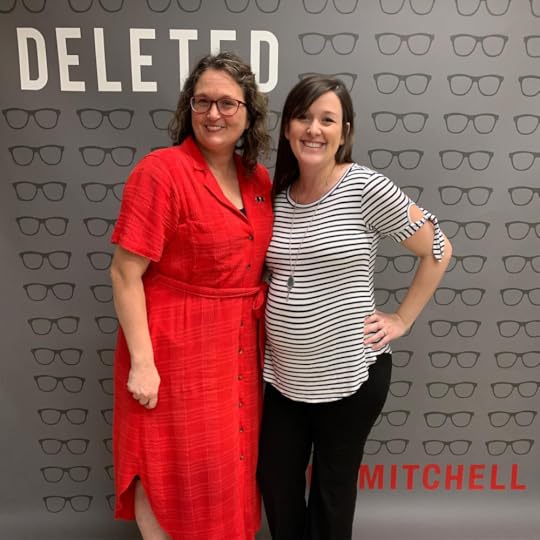
Immortal Works Author Highlight: Deleted by Ruth Mitchell

When I first became an acquisitions editor, I had no idea the amazing roller coaster ride it would be. Sending rejection letters to my fellow authors was tough. I knew how hard it was to be in the query trenches, but even thought I was reading plenty of manuscripts, I wasn't finding any that captivated me.
Until this one.
I saw Ruth pitch her novel Deleted as part of the #Pitmad event on twitter and liked her post. Her query was wonderful and her first pages were engaging, so I requested a full manuscript. She replied promptly and I opened the document to get a sneak peek of what she had for me, and I couldn't put the book down until 2 AM.
Ruth's stunning voice knew how to pull me in from the very beginning. Every page was packed with dangerous tension, authentic characters, and a sensational romance that kept me up till two in the morning reading.
ABOUT THE BOOK:
She knew mind-hacking was wrong but didn't realize it was dangerous.
Just when Lucy's long-term crush, Marco, seems to be falling for her, a mysterious hacker erases her from his mind—and everyone else's.
Lucy's quirk of not wearing Spex is the only thing keeping her safe from the man trying to steal her memories. But it's hard when the hacker hunting you has eyes everywhere.
Now as a total stranger, Lucy seeks Marco's help. If the hacker finds them, he'll erase their memories or worse. If they fail to find him--and stop him -- no one will know that minds can be hacked and lives rewritten.

MEET THE AUTHOR:
Ruth is an amazing author, bookstagramer, baker, and colleague. She and I chat frequently about our books and I have been so impressed by how hard she works to make her career a success. She threw the most incredible release party for Deleted and I was thrilled to only live an hour away so I could make it! The thing I love most about Ruth's book is how it stayed with me for days afterward. I had the same kind of feeling I felt after discovering Andrew Lloyd Webber's Phantom of the Opera for the first time. Everything about her story was romantic, thrilling, dangerous, and exactly the kind of thing I love to read. If you're looking for a clean, fast-paced, romantic read, this is definitely for you!

November 10, 2020
Writing Without Coffee: Finding Motivation during Nanowrimo

Staring at a word document can be the most daunting thing in the world. I often wonder how my brain can work through plot holes, catch mistakes, or even make sense of one more page. Last year, as I geared up for another ,Nanowrimo, I read a motivational essay whose first bullet point for success was: DRINK LOTS OF COFFEE!
I laughed, but once I got in the thick of Nano madness, I realized that a caffeine rush could help propel my productivity. Now, I don't drink coffee, so instead, I began the tradition of starting each writing session with a mug of Stephens hot chocolate.
It was lovely.
On those cold, November mornings, I looked forward to my mug and keyboard. I completely understand how people get attached to such a calming moment with themselves. Plus, I finished my 50,000 words in just twenty-two days of writing. It was incredible!
But, drinking that many calories isn't sustainable and I need to be productive every day. Some mornings, I dread sitting down to my keyboard because I have no idea how to crush any more crappy words out of my brain. It is much, much harder without caffeine.
But I've learned a few things. Ways to dig deeper and let go so I can accomplish my goals regardless of how hard the day is.
1. Take a moment to inspire yourself.
Meditation. Connecting with Nature. Praying. There are so many ways you can feed your soul. Writing is often a spiritual experience for me and I like to involve God in the process. I begin with a prayer, then spend a moment of mediation- not thinking about my book, but thinking about what I believe in. What matters to me. More often than not, those themes find a way into my writing and make it more genuine, complex, and enjoyable.
Next, fill your creative well. Look at photographs and notice the fine details. Think of ways to describe them. Watch movies and take note of the setting details, emotional gestures, and dialogue. Read classic novels that paint pictures with words. Go out in the world and notice the smells, the temperature, the sounds... Being an author requires you to have experiences and be aware of your senses enough to make other people feel as if they were living through your words.
2. Never hit delete.
I talk about this all the time because it has made such a huge difference in my life. I read somewhere that you can't create and critique at the same time. I love that sentiment. Critique allows for second-guessing and backtracking, the two sure killers of momentum. Let your fingers run away with your keyboard. Let them spell out exactly what your mind is thinking, without worrying about sentence structure, consistency, or grammar. You'll find that though you make mistakes, your words will be vibrant, raw, and impulsive. Your draft may be riddled with cliche's or plot holes, but those are things that can be fixed. Just finish the scene. You'll have an emotional guidepost to build onto till you have a perfect picture.

3. Don't expect a final draft.
Have you ever seen an animated film storyboard? The pictures are sloppy, often colorless, but when you pair them next to the finished product, they are unmistakably the same scene. The storyboard captures the emotions and plot the storytellers wanted to portray. When you are writing a rough draft, you are sketching the storyboard. You are in no way completing a finished product. Don't stress yourself out by telling yourself that it is.
But after the rough draft, it's easy to think "Ok, NOW it has to be perfect." But guess what. Your second draft is allowed to be terrible. Your third draft can make huge mistakes. The only thing that matters is that it's slowly taking shape. By expecting a shiny final draft in the early stages of writing, we cripple ourselves with perfectionistic expectations. By letting go and allowing ourselves to make mistakes, we increase our production because we aren't holding ourselves back!
One of my critique partner's husband gave me some great feedback during the last writing group (we often get guest appearances by our supportive families during our video chats.) He said that often authors mention in their acknowledgments that they "never thought this book was ready for publication." Think of that, New York Times bestsellers still feel like it's not a final draft! So, the sooner we let go of the idea that we have to get it perfect before we send out our manuscript, the more productive we will become.
4. Let out a stream of unconsciousness.
On a recent ,Writing Excuses podcast about fear and writing, ,Mary Robinette Kowal said a question she asks herself is "Why don't you sit down and write about why you're not writing? What are the barriers that stand between me and the next scene I need to write? Eventually what winds up happening is that I start noodling on the scene and then suddenly the part of my brain that is delighted by writing is like "Wait, may I have the drivers' seat now?"
One of my favorite therapy books as a writer is called ,The Artists Way by, Julia Cameron. One of the first things Julia instructs readers to do is get in the habit of writing 'morning pages'. These are meant to be a stream of unconsciousness. Morning pages are meant to help you expel all your fears firsthand, then have a free and open mind as you begin writing your story.
5. Find a support group.
Family can be some of your biggest cheerleaders. I call my mom all the time to run ideas past her, and my siblings are often some of my first beta readers. I look to my husband for confidence and support when I need to hit deadlines. (I can't say how many times he's made dinner for the family while I'm locked in my office.)
Even though I live two states away from my writing group, they are some of my dearest friends. There have been times when all of us have video-chatted just to write together. Most of our time was spent in silence, typing madly on our keyboards, but there was something about the sound that made me feel so supported. Like I could actually follow through and do this! Every time I see their updates on Facebook, or get a text from them, or run an idea past them I am motivated and reminded that I deserve to be writing.
Find people online who share your passion. Facebook groups, twitter, blogs... You can find communities no matter where you look. One of my favorites I used when I was just starting out was ,Scribophile.com. I met online critique partners and got excellent and respectful feedback from there. I'd highly recommend it. My new favorite community for writing is called ,4thewords.com, a role-play game where you defeat bosses by reaching timed wordcount goals. It is the BEST thing for productivity.
Writing with caffeine is still an occasional treat I give myself. For example, when I have a day without the kids, I'll really try to maximize my time by gaining a few pounds with sugary caffeinated fuel...
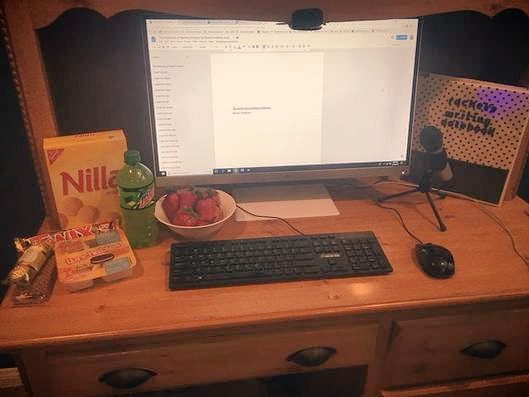
But to be completely honest, the biggest most reliable kind of production is in the regular, self-disciplined days. The small, steady output is better than any desperate race to catch up. Not only do you have consistent momentum, but you'll avoid writer's burnout. Try it and let us know what tips and tools work for you!
Now, time for me to get back to writing my novel.
Happy Writing!
November 3, 2020
Eliminate Passive Voice from Your Writing

Once, in writing group, we held a passive voice clinic. Each of us sought out passive sentences from our current works in progress and obliterated them. By the end of the night, we each felt so energized and inspired, I thought it would be awesome to invite you to join a mini clinic here with me. I will post the discussions we had and the problems we worked through so you can edit right alongside us! So whip out your work in progress and get ready to improve your writing!
Why is passive writing such a detrimental thing? Essentially it comes down to two crucial facts. First, writing in a passive voice pulls your readers out of the action. Active voice will put your reader in your character's shoes and envelope them in the story. Second, passive writing muddies up your sentences with filler words. For example, here's an excerpt from Shattered Snow rewritten in passive and active voice:
Passive:
She had been expecting—no, not expecting—hoping for this letter. Her eager fingers were greasy and they left black fingerprints all over the pure white surface. She was so desperate to open it that she really didn’t care. Inside was an entire packet, neatly stapled together at the top.
Word count: 50
Active:
She expected—no, not expected—hoped for this letter. Her eager fingers left greasy fingerprints on the pure white surface. She felt too desperate to care. Inside sat a neatly stapled packet.
Word count: 32
I didn't change any of the content, but I eliminated 28 words bogging down the pace of my story.

So, with these two benefits in mind, let's move on to the grammatical rules of passive vs. active writing. Each sentence you write has a subject and a verb. The subject is the noun that will be doing something in your sentence. However, utilizing the correct verbs are will become the core of your success.
In active writing, the subject acts.
In passive writing, the subject is acted upon.
Active: The car hit me.
Passive: I was hit by the car.
Do you see how wordy the passive sentence is and how punchy the active sentence is? Now, if this concept is a little hard to grasp, don't worry. You can read up about it ,,here in greater depth, but here's a quick tip to help you kick out passive sentences aggressively...
The verb "to be" and all its conjugations are the culprit behind most passive writing. So, if you press control+f in your word processor and search out the following words, you will isolate the sentences that need editing.
Be, Am, Is, Are, Was, Were, Been, Being.
At first, when my publisher gave me this recommendation for a self-edit round, my jaw dropped. These words are so common! Could I really make it through my entire manuscript without using these? I began my search, slowly rooting out these words and I cut out over 5,000 words without cutting any scenes or plot. That means that I had 5,000 words of clutter sitting in my manuscript bogging it down! Once I removed these words, I was amazed at how different my manuscript looked. I can't wait for you to see what it does for you!
So, search through your manuscript and find "to be". Leave a comment with your before and after sentences for me to see. And if you have any questions, feel free to reach out.
Happy writing!
October 27, 2020
Behind the novel, "Shattered Snow"

Just over a year ago now, I went to writing group and said, “I have an idea, and I want it completed in three months.” Start to finish, drafted and edited, my goal was to pitch this story to a publisher at ,,LTUE, a large writing conference held in Provo, Utah every year. There was a fire deep inside me telling me that after eight other manuscripts, this—THIS was it. I worked on a dedicated schedule, making the word count happen. Fast forward, and I not only accomplished my goal, but received an offer for publications at ,,Immortal Works.
My dear friend, acquisition editor Amanda Hakes, wrote a wonderful description of Shattered Snow after I sat down with her for a brief interview. Here's what she had to say.
",,Shattered Snow is about Keltson Grammar, a man who willingly breaks the laws restricting time travel so he can rescue the under-looked and the unfortunate throughout history. He hides his identity under the guise of a white-masked face in a mirror, never revealing to his clients or their rescuers who he is. But when his mission catches the eye of Lilia, a woman who wants to escape her present more than anything, and consequently sucks in Margaretha, a young countess who is destined to die, his vigilante missions and his hidden identity may just come crashing down.
Rachel’s novel is rich with historical details, utilizing them to both trap and uplift the characters inside. She has created a time travel experience that is fresh and enchanting. If you have ever wanted to time travel, this story will scratch the itch. If you have stuck up your nose at time travel in the past, this may have you re-thinking your prejudices.
One of my favorite parts of the novel is the chapter heading documents, historical or otherwise, that give you a glimpse into the depth of the consequences at hand. These are so well written that even those documents dated for 2069 read as if they are 100% real. There are also gorgeous illustrations by artist,, Kaelin Twede laced throughout that absolutely bring the story to life.
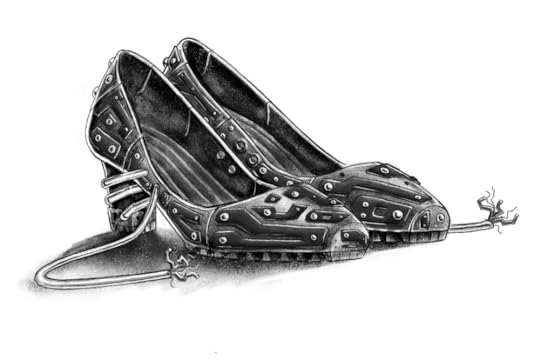
But the true page-turners of Rachel Huffmire’s novel are the characters. Without a hard eye on good and evil that exists in most fairytales, Rachel is able to build up even the villain as someone we want to succeed, though we know it would mean disaster. If there were ever a batch of characters I wished could get their happy ever after, these three would be it.
I’m bringing on Rachel to talk about the creation of ,,Shattered Snow—the way the process made her grow, the way she developed an intriguing spin on time travel, and the inside scoop on the characters that drive the story.
Amanda Hakes: Both historical fiction and science fiction takes an immense amount of research. Now, you have combined the two! Being the fantastic researcher you are, I know you’ve delved into all kinds of sources to get deep into the subject you're writing about. What are some of your favorite things you learned while researching for Shattered Snow?
Rachel Huffmire: I absolutely loved researching for Shattered Snow. Time travel is a perfect ingredient for Snow White’s story... and plenty of other fairy tales for that matter. Bringing in real-life historical facts was important to me, so I scoured the internet and library for any information I could get my hands on.
One of my favorite things I learned was about Margaretha von Waldeck and how she was likely the inspiration for the Grimm Tale. Getting to know a real person’s story brought the character to life. I took virtual tours of the castle she grew up in, read translated German research papers about her tie to the Grimms fairy tale, found oil paintings that still hang in the Waldeck Castle, studied her family tree, meandered through the forest around her home via google street view, learned about her religion, and everything else I could! The internet is an amazing resource.
I also conducted plenty of research on the time period. I was constantly faced with questions like “Would Lilia use a doorknob to exit a room? Could she lock the door?” As tedious as it might sound to stop and research doorknobs for fifteen minutes in order to get one small detail right, it was so important to me to make it as accurate as possible. (by the way, did you know that doorknobs weren’t patented until 1878 by a Mr. Dorsey? Tell me that’s not ironic.)
Even after the work I put in, Immortal Works hired a proofreader to fact check all my research. I was amazed at how thorough my editor was. She found so many enriching details that made this story even more historically accurate.
AH: The trope most associated with time travel is that when someone goes back in time to fix a bad thing, that fix changes so much of the present that they usually decide life was better the way it was, so they set out to straighten the mess they made. The downside of this trope is that none of the consequences have their intended impact because time travel can fix it. But Shattered Snow takes this trope, and its faults, and improves it. If the timeline is changed, there will be legal consequences. If you go back too many times in the attempt to fix what went wrong, there are physical ramifications. What inspired you to write time travel this way? What are some of your thoughts on the way time travel is used in your favorite stories?
RH: When I was young, I played a game called the Journeyman Project. It had a big bad guy who messed up time and a government agent who had to restore it to the way it originally was. I remember being so frustrated as my agent interacted with the past that I wasn’t allowed to help some of the smaller subplots I came across in the past. As I began thinking about time travel, those frustrations resurfaced, and I realized having a character who went beneath the law to make those changes as a good guy would make an exciting story and one that I wanted to explore.
As far as turning those tropes you spoke of on their head, the best fantasy and science fiction stories all require their cool gadgetry or magic to come with a cost. Even though my time travel is science fiction based, I treated it as if it were a magic system. Brandon Sanderson talks about ,,demanding magical consequences. This is what makes the story interesting, or else they could just go back and fix things whenever they wanted.
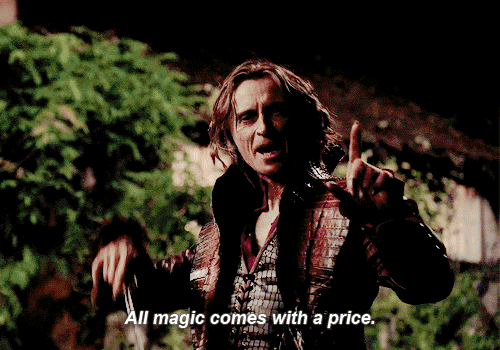
AH: The Pause, cold and isolated, is a place in-between time that Keltson uses to keep control of his projects. I love that this place you created perfectly represents the collision in your story between magic and technology. Tell me how you came to the beautiful idea of all organic matter in The Pause visually splitting into everything it could become?
RH: Stopping time has always been interesting to people and is an idea found frequently in fiction. As I thought about how I could make this idea unique to my world, I realized that it’s an unnatural state; therefore it needed to feel unnatural to people who stepped into it. I figured if time paused, light would no longer move naturally, thus, walking through space would create odd shadows in the air that wouldn’t fill back in. Also, frozen time demanded that it be cold, both in a literary and scientific sense.
When I read about Snow White running through the forest where animals jumped out at her, and branches tugged at her dress, I needed the forest somehow growing and living despite it being paused. I actually pulled the idea of shattering from another book I had outlined, where a girl was able to see all the future versions of herself, depending on what path she took. The combination turned out to be really exciting.
AH: Lilia, Keltson, and Bianka have these captivating lives. Each of them is so unique, but I specifically love Lilia’s chop shop background. What was the process like discovering where Lilia worked, or the background that went into Keltson and his family?
RH: I don’t do a lot of character development before I write a story because for me the characters develop as the plot demands. I found Lilia had to be excellent at repurposing broken time travel equipment to fulfill her purpose in the plot, so putting her in a chop shop helped justify some of her expertise and make her more believable. She also had to be really desperate to stay in the past, so making her completely destitute in the future also became a necessary part of her.
For Keltson’s background, I originally wanted him to be an antihero, but he just came out with such a strong moral compass as I wrote him, that I let him do his own thing. He didn’t have a family in the first drafts. But one day during edits, his street rat brother showed up, and suddenly the Grammar family existed: a gambling father and two runaway sons. Surrounding Keltson in a life of crime and to see him still care about morality made me love him even more. It suited Keltson’s role as The Mirror well, to be willing to break the law (because that’s all he’s known his whole life) but to do it for altruistic reasons.
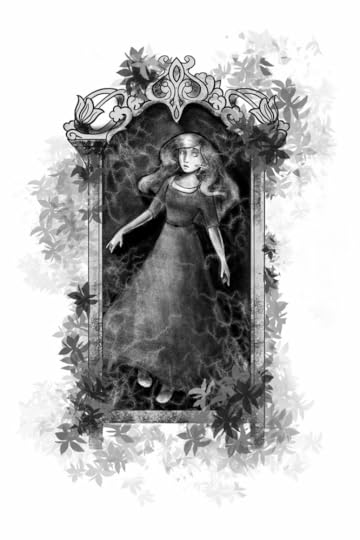
AH: I know that when you began writing this book, you went back and forth on what to name your Snow White character. What led to the decision to meld the historically accurate name of Margaretha von Waldeck with the name you felt drawn to (Bianka) for the character?
RH: I put a lot of weight in the names of my characters. If you look up the meaning of each character’s name, they are blatant descriptions of who they are. For example, Bianka means white, or pure. I feel like changing her name from Margaretha to Bianka as The Mirror interfered with her timeline showed how her path truly became different from the one fate intended for her, turning her more readily into the Snow White we all know and love. And without giving any spoilers, had significant weight to the ending of the plot. After you read it, we can talk. ;)
AH: This was your debut novel, and you're publishing traditionally with Immortal works, which means upon signing you had access to a crew of designers, editors, and a publisher who all had your book's success in mind. What parts of this process surprised you? What are some of your biggest takeaways?
RH: I honestly love the family at Immortal Works. They are all genuine gems, and every interaction with them teaches me something new. I was surprised by how much I learned through the editing process. I’ve been writing every day for seven years and felt like I had a pretty good handle on what made good writing. But after receiving the self-edit packet, and applying their editing standards, I immediately felt like I was looking at an author who was publishable. It didn’t feel like me at all- mainly because I wasn’t using passive voice anymore.
Then, once I started working with my editor, she dropped some major truth bombs about who was the actual protagonist of my story and helped me know exactly where I needed to start the book. Her advice and corrections throughout taught me so much about using every single word to build images in the readers’ minds. It’s been a lot of hard work, but I definitely think the learning curve this year has shaped me to be better.
AH: It’s never too early to talk about the next thing! What other books are you working on right now?
RH: I am more than halfway done with the final book in the series, Saving Winter, and hope to have the rough draft done for Nanowrimo. I have a new series starting up in January called Granted: Curse of the Emerald Jinn, and six other finished manuscripts on the backburner. I’m not giving up on them. They’ll be out someday.

I want to thank Amanda for the amazing interview, and if you have something you are ready to query, let me send you her way with your manuscripts! Check out the submissions page for Immortal Works,, here!
Happy Writing!

You can find the eBook and Audiobook versions of Shattered Snow ,,here,
or you can visit my shop to purchase a personally signed paperback edition ,,here.
October 20, 2020
Pitching your novel

In October 2017, a new novel concept popped into my head. I completed my first draft during Nanowrimo, then five drafts and three months later, I packed my bags, put my two little cuties in my CRV, and drove ten hours to LTUE in Utah to pitch my completed novel.
Sometimes moms have to chase their dreams. (Shoutout to my amazing husband!)
My previous pitch sessions with publishers and agents taught me a lot, so during this round I felt like a tween wearing high heels for a second time. Hopefully, my ankles were a little stronger for this round. I pitched my novel to two publishers while I was there and received two partial requests. One month later, I signed my first book contract with Immortal Works!
Pitching to their chief editor, Holli Anderson, was such a good experience. I immediately loved every single person I met from their company. That's the amazing thing about pitching; both parties get to put a face to the name. I knew from talking and meeting with them that I felt comfortable working with these people. Not all of my pitches have gone that way.
I have been writing for seven years now and I have a spreadsheet of query rejection letters that would make your eye twitch. On this journey, I've found some great resources and also some really bad advice. So, hopefully, I can help sort through a few things that I wish I had known about getting ready to pitch.
1. Realize this will be a learning process.
After Theodore Geisel received his twenty-seventh publishing rejection he thought about burning his manuscript and giving up. He later became known as Dr. Seuss and currently sells 11,000 books a day. (You can read how he finally sold his first book ,here.) The point is, don’t be hard on yourself. Don’t think that rejection letters mean your ideas aren't good enough. You are buckling up for a long haul here, and while it's not for the faint of heart, you can do this! You can place your manuscript in the right pair of hands. You can handle rejection letters. You can be successful at whatever you choose to do. So decide now to keep learning, to push through rejections, and to celebrate the victories.
2. Finish your book.
Unless you’re writing non-fiction and have a book proposal (a whole different ball game), you need to have your manuscript in as good a shape as you can make it. If there’s still something you know needs to change, don’t pitch it until it’s done. Send it through a critique group to catch things you can’t see anymore. I'm not talking about fine syntax and punctuation; small errors won’t drive away editors. But the building blocks of your story, the characters, the things that need time and brainpower to work through... Get them done first. You can do it.
3. Query.
The backbone to your pitch is a query. Read about queries. Read how other people write them. Read agent and editor submission guidelines. I started with an e-book called ,From the Query to the Call by Elana Johnson. It's a great resource, and I highly recommend it. ,Queryshark is also a helpful to see what other people are writing and how they are being critiqued.
4. Research.
After I drafted my first query—I sent it to all the wrong people. You'll only be successful if you put your novel in the correct hands. Just because an agent accepts science fiction doesn't mean they will represent your steam-punk romance. Find books comparable to yours and find out who represents them. Those are your people.

5. Practice.
Sending a query might seem easier than delivering a pitch. At least you can edit those words. Practice is the key to getting ready. Practice on your family, writers group, or even better- strangers! The girls in my writing group, Writing Through Brambles, have always been an amazing support. One year, they came up with the ingenious idea to make t-shirts for a conference we were all attending that said "Ask me about (insert current novel name here)". All weekend, I had strangers stopping me to ask me about my book. I started with my logline, then if they were interested I'd launch into the rest of my pitch. It helped me get over my jitters before I actually went in to pitch it to publishers.
Warning: some of the bad advice I saw online was to "always sign up for pitch sessions, even if they don't represent your kind of work. You can always use the practice." Agents/Editors are not the people you practice on. Not only is it a waste of your money, but it's a waste of their time. Treat them professionally.
6. Prepare for questions.
Know your book inside and out before you go into a pitch session. Publishers and agents can ask you anything. Here are a few examples of questions I had during a few of my pitches.
Example #1: After I gave my log line, the editor asked detailed questions about my story arc, character motivations, the height of the conflict, and costs. By the end of the session, they knew my story so well they picked out a plot hole and gave revision recommendations.
Example #2: The editor liked my idea, then asked if I had any other work. Luckily, I was prepared to pitch a second novel, because that’s the one they were most interested in.
Example #3: The editor and I had a great chat, then things started wrapping up early. They asked if I had any final questions or statements. I took that time to give them my bio and marketing abilities. I wouldn't have thought to include those things if I hadn't prepared to answer them.
7. Pitch.
This is your moment. Have fun with it! Pitching shows the agent/editor you are interested specifically in them. It puts a face to your name on your query. It's your time to show your passion for your story. You've got this!
Imagine the query slush pile as a line at the DMV. You'll eventually get your turn, but waiting is part of the process. Pitching is scheduling an appointment to get you to the front of the line (I wish I would have learned about that DMV function sooner). Remember that editors and agents are human. I pitched to someone who was having a bad day once. The pitch didn't go so well. That's okay. I got really nervous during a pitch and didn't come across very professional. I survived. We are all human. Just keep trying and you'll find those magical moments where you and the editor/agent click and have a genuine moment to connect. Those are the people you are looking for.
8. Plan your post-pitch-cool-down.
Pitching is exciting and it's likely you'll have plenty of adrenaline going when you're done. Everyone I know has a different reaction. Some shiver. Some talk faster than normal. Me—I feel like sprinting around the block post pitch (I always wear my Brooks running shoes to conferences). My writing buddy, Bree Moore, had a great suggestion to plan how to come off of that adrenaline. Maybe plug into your i-pod and listen to some meditative music... or something more hardcore if you need to rock out.
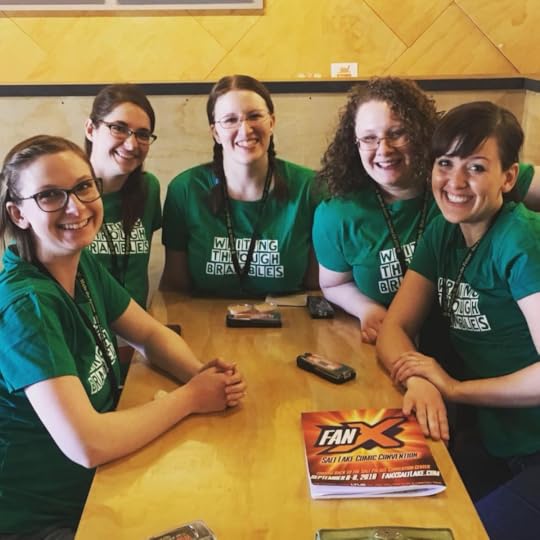
9. Celebrate!
If it goes good or bad, celebrate your accomplishment. I was lucky to immediately have these wonderful ladies around me to celebrate with. They are the best support I could possibly ask for. I am so excited for you and your journey and would love to see your comments with pitch successes and ways you prep. Best of luck to all of you!
October 13, 2020
IW Author Highlight: Colonial Prime by Kevin Nielsen

Being part of Immortal Works is like being part of a family. I have spoken to almost all of their authors either in person or through zoom, and I love their personalities, creative minds, and AMAZING BOOKS. One of the first Immortal Works books I read was ,,Colonial Prime by Kevin Nielsen. It's an action-packed sci-fi novella that I was lucky enough to be a beta reader for back in 2018. Then, I read it again as an advance reader and loved it even more! Kevin is one of the keystone authors who led me to investigate Immortal Works and ultimately sign my own contract with them.
ABOUT THE BOOK:
“Captain Amara Corrin, the hero of the late Solar Wars, commands the first colonial fleet. Full of hopeful dreamers looking for a new home, world-weary ex-soldiers, and those just seeking escape, five ships set out from Earth with the hopes of humanity behind them. But Amara soon finds herself with more trouble than she can handle. The Council, Earth’s new governing body, has saddled her with their political rivals, exiling them to a place where they could do them no harm.
Struggling to find balance, Amara appoints a fresh-faced first officer with a hidden past, Nathan Esquina, and tries to figure out a way to keep her son, Jaelyn, free of the political machinations of those aboard the ship trying to destroy the rocky peace upon which they stand. When a message from Earth lets them know that the Council has fallen, Amara, Nathan, and Jaelyn land themselves in a pitched battle where a single mistake could end not only their own lives but those of every person aboard their colonial mission.
MEET THE CHARACTERS:
Amara Corrin
Though Amara has been hardened by war, she’s never ruthless or antagonizing. She’s exactly the kind of person I would want in charge of colonizing a new planet. Her competence in her professional life, however, doesn’t always transfer to her personal relationships. As tensions on board the ship climb, those very relationships she struggles with could become the only thing that will help her survive.
Jaelyn Corrin
Thirteen-year-old Jaelyn doesn't like attention. Unfortunately, as the son of the ship's captain, it's hard to lay low. He spends his time hiding away in the gardens, but this ship is too small to truly escape getting sucked into the forefront of the adult's problems.
Nathan Equina
Nathan volunteered to join the colonial fleet to get away from his father. He needs a fresh start, where no one has heard of his reputation so he can figure out who he is, and what why he has such a mysterious gift for mechanics. As the distance between Earth grows, his father's problems haunt him, infecting his new haven with the exact same problems he wanted to escape from.

MEET THE AUTHOR:
When I first met Kevin he was at a convention in Provo, wearing a ,purple button up shirt, and watching someone else's baby so they could go to a class. Not only is he a baby whisperer, but he's also a prolific writer who balances a full-time job and family. The thing I love most about his stories is how his characters feel like old friends so quickly. I find myself constantly sneaking away to read his books because I care so deeply about what happens to my peeps! Also, his vocabulary is first-rate and will leave you feeling both entertained and enlightened. His website has some wonderful advice for ,new writers, and he works as an acquisitions editor for Immortal Works.
OTHER BOOKS BY KEVIN L NIELSEN:
When I first met Kevin, I was shocked to learn that he had published three full-length novels in his first year. I own his Sharani series (uh-maz-ing!) and can't wait to get my hands on Resurgent Shadows. His cover art is as beautiful as the stories inside. If you are a fan of Dune by Frank Herbert, the ,Sharani Series is absolutely for you.
October 6, 2020
How to Grow as a Writer: Get Uncomfortable

As writers, we are always chasing an upward trajectory. Higher word counts, query more agents, publish more books, earn more money... There's always another mountain to climb. That's why we attend conferences, read, and join writing groups. If we keep growing and improving, we'll finally make it to our goals where we can sit back comfortably and bask in our accomplishments. Right?
Yes. That is exactly right.
Last year, I found myself feeling pretty good. I had a stable writing group that kept me motivated, I got my first royalty check ever, and my sequel was wrapping up into a neat little package. Things were on track and the Rachel train had some serious momentum (woot woot!). I have to admit, a lot of this momentum comes from a previous year of working my tail off, but right then, I felt like I was coasting, and it felt nice.
To celebrate my comfortable place in the sun, I indulged myself and purchased a ticket to spend two days at the Storymakers conference in Provo, Utah. I have never been to a writing conference outside of LTUE, so I was excited to try something new. It was being held in the same conference center as LTUE, so I expected that it wouldn't be much different than what I already knew. Nice and comfortable.
Nope.
The familiar conference center was completely transformed. Instead of recognizing half of the faces around me, I only knew a handful of people. Instead of knowing exactly which panelists to follow, I was sitting in lectures by people I had never even heard of. I texted my husband…
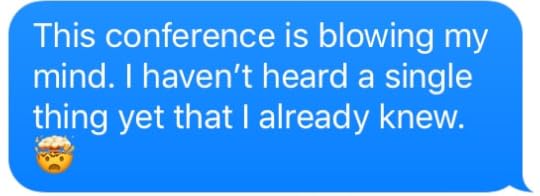
Stepping so far out of my comfort zone shook my foundation. My stomach started growling nervously through the lectures (Rachel White, my writing buddy and audiobook reader, can tell you all about it). I felt like I was missing too much information and furiously scribbled notes so I could go do more research after the lecture.
During lunch, I met up with some girls from my writing group and took a deep breath. I was finally back where I belonged, with close friends, in a zone of comfort and dependability. We looked through the list of upcoming classes and I saw some titles that absolutely terrified me. Math for writers? Mastering Facebook Ads? Yikes! I don't even know the first thing about that.
...
I don't even know the first thing about that.
...
I suddenly realized that the only reason I felt afraid or uncomfortable was because I was blazing new territory. I DIDN'T know what to expect. There was an empty shelf in my brain waiting to be filled with information, and I needed to go to these terrifying classes in order to start.
So, I marked down all the scariest sounding classes and started attending them. I was given excel spreadsheets and formulas that I didn't even know I needed. I heard about the psychology of power and the similar function of networks between drug cartels, the internet, and politics. I sat down with an amazing Bookstagrammar, ,,@endlessfairytales, who taught me all the ins and outs of how to use a daunting and unfamiliar social media platform.
I felt lost, uncomfortable, and empowered.
With the new tools I picked up, I realized how I could grow as an author in my craft and my business. I knew how to set specific goals to improve in ways I hadn't considered before. To grow, we have to be willing to do things that make us uncomfortable. It's okay to be nervous to look at numbers. It's okay to be afraid to stand in front of a crowd. But don't let that stop you. The feeling of discomfort is a sign that you are growing. And growth brings success and security. Isn't that a weird thought: being uncomfortable will make me more secure.
Now, allowing ourselves to feel discomfort doesn't mean taking unreasonable risks. Fear and anxiety are often survival instincts. They keep us safe. You shouldn't jump into unsustainable schedules just because you heard that someone else pulled it off. Uncomfortable doesn't mean unhealthy. Uncomfortable means those little stretches that help you grow. It might feel overwhelming to face a new topic, or you might feel anxious to meet new people, but taking those tiny steps into the unknown will help you level up in ways that you might not expect.
So, be like Bilbo Baggins! Get out there and start exploring things that are foreign and scary and unexpected. Don't let yourself miss out on benefiting from a new experience, just because it's unfamiliar.



